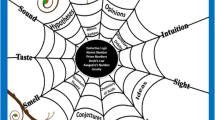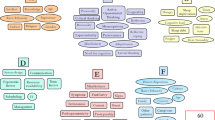Abstract
This paper has five objectives: (a) to review the scientific background of, and major findings reported in, Medical Problem Solving, now widely recognized as a classic in the field; (b) to compare these results with some of the findings in a recent best-selling collection of case studies; (c) to summarize criticisms of the hypothesis-testing model and to show how these led to greater emphasis on the role of clinical experience and prior knowledge in diagnostic reasoning; (d) to review some common errors in diagnostic reasoning; (e) to examine strategies to reduce the rate of diagnostic errors, including evidence-based medicine and systematic reviews to augment personal knowledge, guidelines and clinical algorithms, computer-based diagnostic decision support systems and second opinions to facilitate deliberation, and better feedback.
Similar content being viewed by others
Notes
The fictional detective Sherlock Holmes, perhaps the model of this genre, was inspired by one of Sir Arthur Conan Doyle’s teachers in medical school, Dr. Joseph Bell (http://www.siracd.com/work_bell.shtml).
To give credit, a case can be made that the field of research on clinical diagnosis really began earlier with studies of variation in clinical judgment that are nowadays regrettably overlooked (Bakwin 1945; Yerushalmy 1953; Lusted 1968). The reasons for neglect are unclear and in any event are beyond the scope of this paper, but it is a plain fact that they are cited neither by Ericsson nor Norman, nor by the vast majority of psychologists, physicians and educators who have done research on clinical reasoning in the past 30 years.
References
Albert, D. A., Munson, R., & Resnik, M. D. (1988). Reasoning in medicine. Baltimore: Johns Hopkins University Press.
Bakwin, H. (1945). Pseudodoxia pediatrica. New England Journal of Medicine, 232, 691–697.
Berner, E. S., Webster, G. D., Shugerman, A. A., Jackson, J. R., Algina, J., Baker, A. L., et al. (1994). Performance of four computer-based diagnostic systems. New England Journal of Medicine, 330, 1792–1796.
Bordage, G. (1994). Elaborated knowledge: A key to successful diagnostic thinking. Academic Medicine, 69, 883–885.
Bordage, G. (1999). Why did I miss the diagnosis? Some cognitive explanations and educational implications. Academic Medicine, 74, S138–S143.
Bordage, G., & Lemieux, M. (1991). Semantic structures and diagnostic thinking of experts and novices. Academic Medicine, 66(9), S70–S72.
Bordage, G., & Page, G. (1987). An alternative approach to PMPs: The “key features” concept. In I. R. Hart & R. M. Harden (Eds.), Further developments in assessing clinical competence (pp. 59–75). Montreal: Can-Heal Publications.
Chapman, G. B., & Elstein, A. S. (2000). Cognitive processes and biases in medical decision making. In G. B. Chapman & F. Sonnenberg (Eds.), Decision making in health care: Theory, psychology, and applications (pp. 183–210). Cambridge: Cambridge University Press.
Chomsky, N. (1957). Syntactic structures. The Hague: Mouton.
Croskerry, P. (2003). The importance of cognitive errors in diagnosis and strategies to minimize them. Academic Medicine, 78, 775–780.
Dawson, N., & Arkes, H. R. (1987). Systematic errors in medical decision making: Judgment limitations. Journal of General Internal Medicine, 2, 183–187.
Dawson, N. V., Arkes, H. R., Siciliano, C., Blinkhorn, R., Lakshmanan, M., & Petrelli, M. (1988). Hindsight bias: An impediment to accurate probability estimation in clinicopathological conferences. Medical Decision Making, 8, 259–264.
De Groot, A. D. (1965). Thought and choice in chess. The Hague: Mouton.
Elstein, A. S. (1994). What goes around comes around: The return of the hypothetico-deductive strategy. Teaching and Learning in Medicine, 6, 121–123.
Elstein, A. S. (1999). Heuristics and biases: Selected errors in clinical reasoning. Academic Medicine, 74, 791–794.
Elstein, A. S., Schwartz, A., & Nendaz, M. (2002). Medical decision making. In G. Norman, C. van der Vleuten, & D. Dolmans (Eds.), International handbook of medical education. Boston: Kluwer.
Elstein, A. S., Shulman, L. S., & Sprafka, S. A. (1978). Medical problem solving: An analysis of clinical reasoning. Cambridge, Mass.: Harvard University Press.
Elstein, A. S., Shulman, L. S., & Sprafka, S. A. (1990). Medical problem solving: A ten-year retrospective. Evaluation and the Health Professions, 13, 5–36.
Ericsson, K. A. (2007). An expert-performance perspective of research on medical expertise: The study of clinical performance. Medical Education, 41, 1124–1130.
Friedman, C. P., Elstein, A. S., Wolf, F. M., Murphy, G., Franz, T., Miller, J., et al. (1999). Enhancement of clinicians’ diagnostic reasoning by computer-based consultation: A multi-site study of 2 systems. JAMA, 282, 1851–1856.
Graber, M., Gordon, R., & Franklin, N. (2002). Reducing diagnostic errors in medicine: What’s the goal? Academic Medicine, 77, 981–992.
Groopman, J. (2007). How doctors think. New York: Houghton Mifflin.
Gruppen, L. D., & Frohna, A. Z. (2002). Clinical reasoning. In G. Norman, C. van der Vleuten, & D. Dolmans (Eds.), International handbook of medical education. Boston: Kluwer.
Hamm, R. M. (1988). Clinical intuition and clinical analysis: Expertise and the cognitive continuum. In J. Dowie & A. Elstein (Eds.), Professional judgment: A reader in clinical decision making. New York: Cambridge University Press.
Hunink, M., Glasziou, P., Siegel, J., et al. (2001). Decision making in health, medicine: Integrating evidence and values. New York: Cambridge University Press.
Kahneman, D., Slovic, P., & Tversky, A. (Eds.). (1982). Judgment under uncertainty: Heuristics and biases. New York: Cambridge University Press.
Kassirer, J. P., & Kopelman, R. I. (1991). Learning clinical reasoning. Baltimore: Williams & Wilkins.
Klayman, J. (1995). Varieties of confirmation bias. In J. Busemeyger, R. Hastie & D. L. Medin (Eds.), Decision making from a cognitive perspective: The psychology of learning and motivation (32, 385–418).
Lusted, L. B. (1968). Introduction to medical decision making. Springfield, IL: Thomas.
McGuire, C. H., & Solomon, L. (1971). Clinical simulations. New York: Appleton-Century-Crofts.
Miller, G. A. (1956). The magical number seven, plus or minus two. Psychological Review, 63, 81–97.
Newell, A., Shaw, J. C., & Simon, H. A. (1958). Elements of a theory of human problem solving. Psychological Review, 65, 151–166.
Newell, A., & Simon, H. A. (1972). Human problem solving. Englewood Cliffs, NJ: Prentice-Hall.
Norman, G. (2005). Research in clinical reasoning: Past history and current trends. Medical Education, 39, 418–427.
Patel, V. L., & Groen, G. (1986). Knowledge-based solution strategies in medical reasoning. Cognitive Science, 10, 91–116.
Patel, V. L., & Groen, G. J. (1991). The general and specific nature of medical expertise: A critical look. In A. Ericsson & J. Smith (Eds.), Toward a general theory of expertise: Prospects and limits (pp. 93–125). New York: Cambridge University Press.
Patel, V. L., Groen, G., & Frederiksen, C. H. (1986). Differences between medical students and doctors in memory for clinical cases. Medical Education, 20, 3–9.
Sackett, D. L., Haynes, R. B., Guyatt, G. H., & Tugwell, P. (1991). Clinical epidemiology: A basic science for clinical medicine (2nd ed.). Boston: Little Brown.
Sackett, D. L., Richardson, W. S., Rosenberg, W., & Haynes, R. B. (1997). Evidence-based medicine: How to practice and teach EBM. New York: Churchill Livingstone.
Schiff, G. D., Kim, S., Abrams, R., Cosby, K., Lambert, B., Elstein, A. S., et al. (2005). Diagnosing diagnosis errors: Lessons from a multi-institutional collaborative project. Advances in Patient Safety, 2, 255–278. Available at www.ahrq.gov/downloads/pub/advances/vol2/Schiff.pdf.
Schmidt, H. G., Norman, G. R., & Boshuizen, H. P. A. (1990). A cognitive perspective on medical expertise: Theory and implications. Academic Medicine, 65, 611–621.
Schwartz, A., & Bergus, G. (2008). Medical decision making: A physician’s guide. New York: Cambridge University Press.
Schwartz, A., & Elstein, A. S. (2008). Clinical reasoning in medicine. In J. Higgs, M. Jones, S. Loftus, & N. C. Christensen (Eds.), Clinical reasoning in the health professions (3rd ed., pp. 223–234). Boston: Elsevier.
Sox, H. C., Jr., Blatt, M. A., Higgins, M. C., & Marton, K. I. (1988). Medical decision making. Boston: Butterworths.
Sox, H. C., & Rennie, D. (2008). Seeding trials: Just say “No”. Annals of Internal Medicine, 149, 279–280.
Swanson, D. B., & Stillman, P. L. (1990). Use of standardized patients for teaching and assessing clinical skills. Evaluation & the Health Professions, 13, 79–103.
Wolf, F. M., Gruppen, L. D., & Billi, J. E. (1985). Differential diagnosis and the competing hypotheses heuristic: A practical approach to judgment under uncertainty and Bayesian probability. JAMA, 253, 2858–2862.
Yerushalmy, J. (1953). The reliability of chest roentgenography and its clinical implications. Diseases of the Chest, 24(2), 133–147.
Acknowledgments
An earlier version of this paper was presented as a keynote address at a conference, “Diagnostic Error in Medicine,” held in Phoenix, AZ, May 31-June 1, 2008. I thank the organizing committee—Eta Berner, Pat Croskerry, Mark Graber, and Gordon Schiff—for the invitation and for encouraging personal reflections on the subject. My co-authors and students have taught me a great deal. I owe much to my colleagues in the field, some cited in this paper and some not. Errors of facts and interpretation are my sole responsibility.
Author information
Authors and Affiliations
Corresponding author
Rights and permissions
About this article
Cite this article
Elstein, A.S. Thinking about diagnostic thinking: a 30-year perspective. Adv in Health Sci Educ 14 (Suppl 1), 7–18 (2009). https://doi.org/10.1007/s10459-009-9184-0
Received:
Accepted:
Published:
Issue Date:
DOI: https://doi.org/10.1007/s10459-009-9184-0




